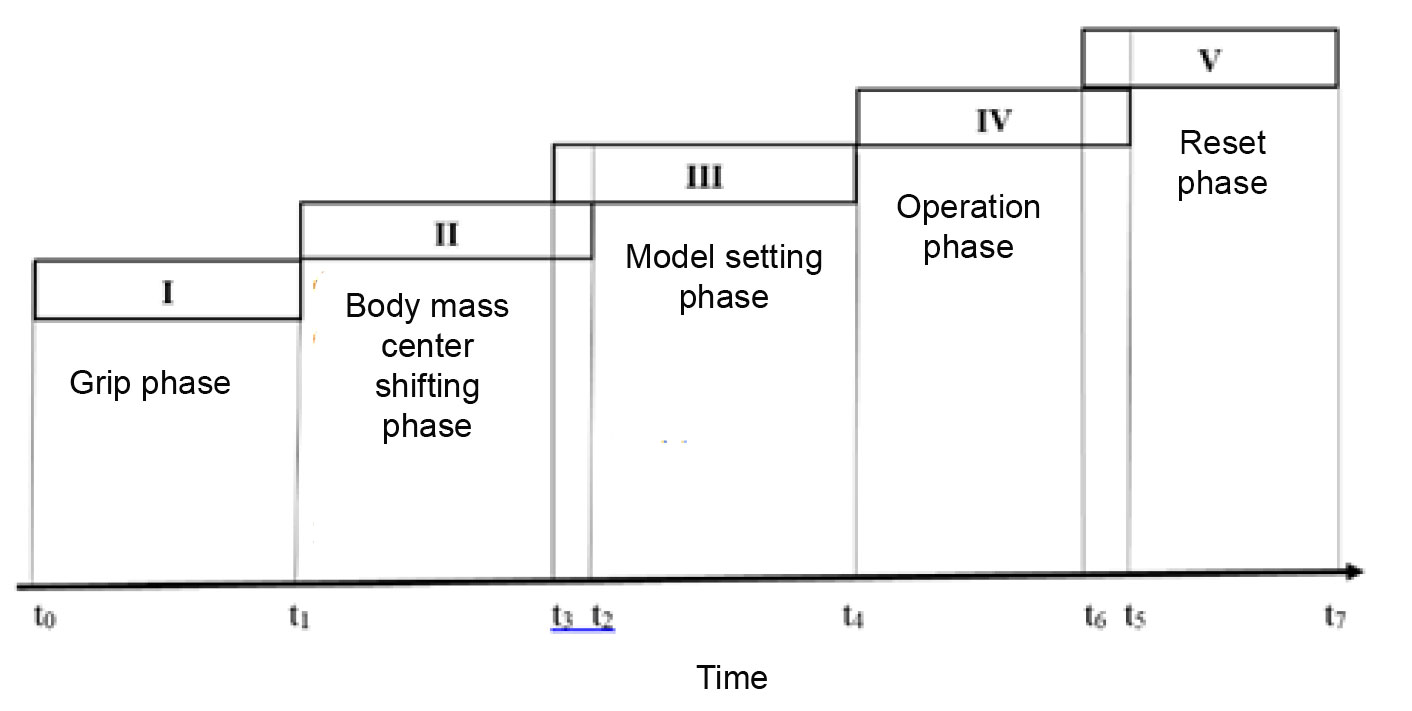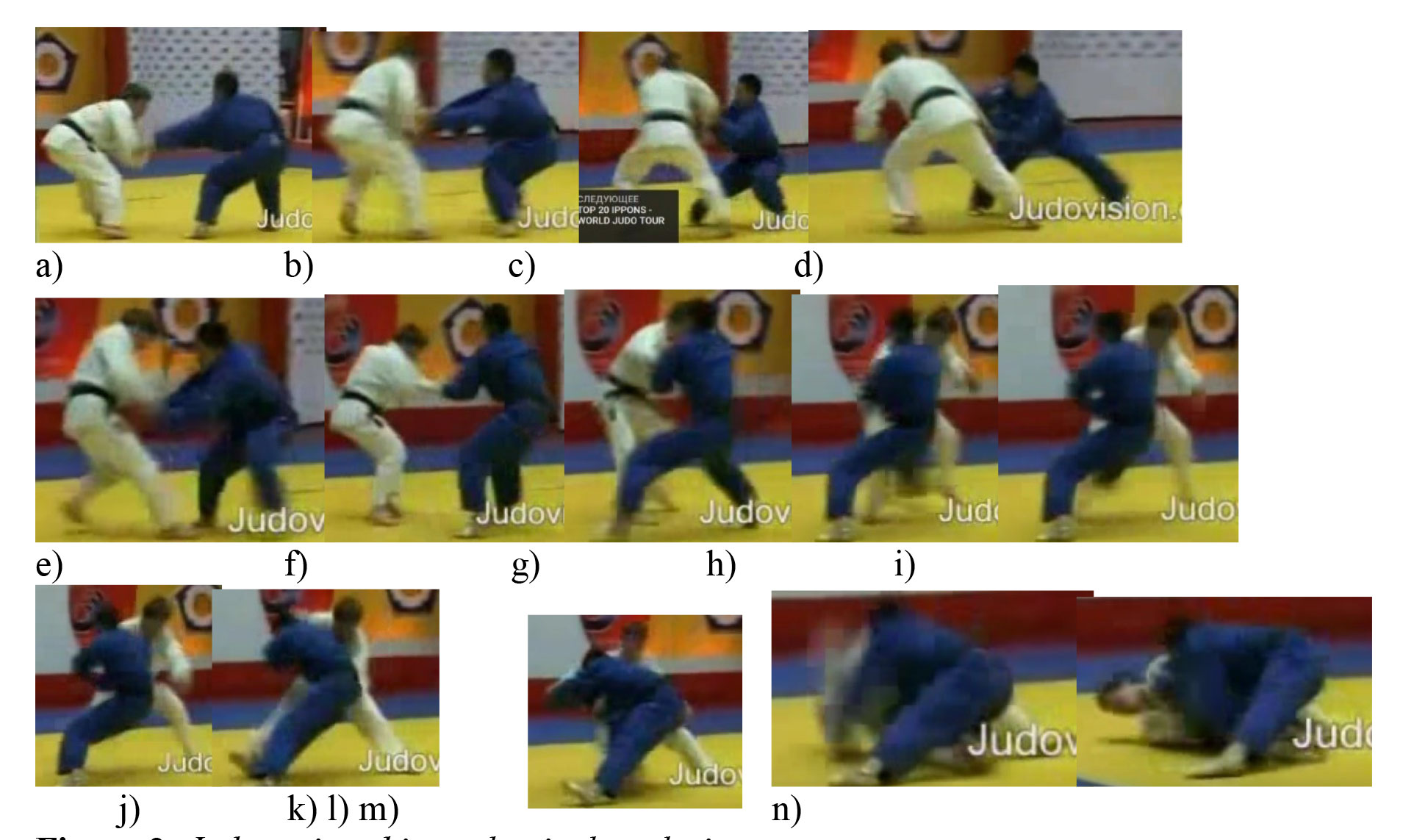Body mass center travel trajectory analysis for ko-uchi-gari in judo bouts
ˑ:
Dr.Hab., Professor A.G. Levitsky1
PhD D.A. Matveyev2
PhD, Associate Professor A.A. Potsipun2
PhD O.V. Oshina2
1Lesgaft National State University of Physical Education, Sport and Health, St. Petersburg
2St. Petersburg State University, St. Petersburg
Keywords: back heel, biomechanics, KO-UCHI-GARI, judo, sambo.
Background. Attacked athlete’s (Uke) body mass center travel trajectory analysis for the back heel action in judo bouts makes it possible to rate the attacker (Tori) action efficiency and profile the movement biomechanics, and to improve the technique and find an ideal execution pattern.
Objective of the study was to profile and analyze the Uke’s body mass center travel trajectory for the back heel (BH) action in competitive judo bouts.
Results and discussion. We used video captures of the back heel techniques downloaded from the Internet [5] to analyze them on a frame-by-frame basis. Each frame was marked (in the left upper corner) by the center of the Cartesian coordinate system followed by indication of the mass centers of the key body segments (trunk, feet, head etc.). The body mass center was calculated as follows:
where ![]() is the abscissa coordinate of the mass center for the body composed of n segments;
is the abscissa coordinate of the mass center for the body composed of n segments;![]() is the n segment mass;
is the n segment mass; ![]() is the abscissa coordinate of the n segment; N is the number of segments; М is the total body mass;
is the abscissa coordinate of the n segment; N is the number of segments; М is the total body mass; ![]() is the ordinate coordinate of the mass center for the body composed on n segments; and
is the ordinate coordinate of the mass center for the body composed on n segments; and ![]() is the ordinate coordinated of the n segment.
is the ordinate coordinated of the n segment.
Since the athletes competed in the same weight class, the individual mass was taken as one, with every segment mass computed in percentage terms (as provided by the regular biomechanics) to the total body mass [1]. In our previous study we offered a classification of wrestling actions into four groups (pairs of forces, lever, block and combined group) based on the A. Sakripanti’s ideas [2, 4]. The classification was complemented by a wrestling action biomechanics model grouping an action into the following five phases [3]: grip phase; Uke’s body mass center shifting phase; model setting phase; operation phase; and reset phase: see Figure 1.

Figure 1. Wrestling action biomechanics model
Given on Figure 2 hereunder is the sample frame-by-frame movement biomechanics.

Figure 2. Judo action: biomechanical analysis

Figure 3. Uke’s BMC movement trajectory in the KO-UCHI-GARI action (see Figure 2)
Given on Figure 2 is the Uke’s body mass center movement curve, with every pre-execution action covered by the analysis. Every point on the curve was analyzed by the prior Figures as follows: point A by Figure 2, point B by Figure 1b etc. The section marked by points N – М on the Uke’s body mass center movement curve refer to the Uke’s body landing on tatami. The section M – L – K refer to the model operation phase (lever scheme in the case). The model setting phase refers to section G – H – I. The Uke’s BMC shifting phase to reach the optimal position for success of the action could be found in section E – F; but actually we do not see Tori’ shifting actions other than rotation (no tipping, toeing, imbalancing etc.). Therefore, Tori employes the Uke’s counterforce to set the desired body mass center movement vector, and in this case it is the only shifting move to secure the Uke’s body mass center being shifted in the optimal position for the throw. It may be concluded, therefore, that the Tori’s shifting action is generally geared to not only shifth the Uke’s body mass center but also set the optimal vector for the throw, with employment of the Uke’s counteraction for success of the imbalancing phaze.
Conclusion. Training systems in the modern judo are recommended to be complemented by the prior Uke’s body rotation mastering exercises to effectively model the competitive situations. The study findings may be used to improve the judo/ sambo training systems in university groups, children and youth sport schools and youth sport clubs in the beginner to excellence trainings. The study findings and analytical procedure may be implemented in any wrestling sport discipline.
References
- Ivanova G.P., Kichaykina N.B., Samsonova A.V. Biomekhanicheskie metodiki analiza i otsenki tekhniki sportivnykh dvizheniy [Biomechanical methods of analysis and evaluation of technique of sports movements]. Teaching aid. Lesgaft SPbSUPE. St. Petersburg, 2007. 62 p.
- Levitsky A.G., Matveyev D.A., Potsipun A.A. et al. Biomekhanicheskaya klassifikatsiya priemov sportivnoy borby [Biomechanical classification of actions in wrestling]. Teoriya i praktika fiz. kultury, 2017, no. 10, pp. 66-68.
- Matveev D.A., Potsipun A.A., Oshina O.V., Levitsky A.G. Biomehanicheskie fazy vypolneniya priemov v sportivnoy borbe [Throw technique biomechanics in competitive wrestling]. Teoriya i praktika fiz. kultury, 2018. no. 6. pp. 88- 89.
- Available at: http://www.academia.edu/2401906/A_Biomechanical_Reassessment_of_the_Scie... (date of access: 10.02.2018)
- Available at: https://www.youtube.com/watch?v=knZbI0E5DjY (date of access: 02.01.2019)
Corresponding author: dmitrijmatveev@yandex.ru
Abstract
Subject to the study was the attacked athlete’s (Uke) body mass center travel trajectory analysis for the back heel action in judo bouts – to rate the attacker’s (Tori) action efficiency and profile the movement biomechanics, and to improve the technique and find an ideal execution pattern. The article analyzes the body mass center travel trajectory for the back heel action (Ko-Uchi-Gari) in judo bouts using video captures and a frame-by-frame analysis of body mass center movement. Mass centers of every key body segment were computed to find the athlete’s body mass center in every frame. The study data and analysis showed that the Uke’s body mass center was rotated prior to the back heel action. Therefore, it may be beneficial to have the training systems complemented by the prior Uke rotation mastering exercises to effectively model the competitive situations. The study findings may be used to improve the judo/ sambo training systems in university groups, children and youth sport schools and youth sport clubs.



